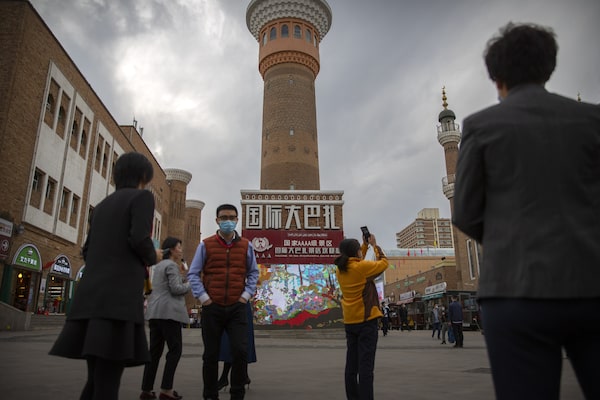
Tourists take photos near a tower at the International Grand Bazaar in Urumqi in western China's Xinjiang Uyghur Autonomous Region during a government organized trip for foreign journalists on April 21, 2021. Independent trips by journalists to Xinjiang are rare and the Chinese government has been arranging tours to Xinjiang for carefully selected foreign journalists and dignitaries, who can be relied upon to give a positive report.Mark Schiefelbein/The Associated Press
It was after 9 p.m. on a Saturday when eight people, dressed head-to-toe in black, burst into the main hall of Kunming Railway Station, in China’s Yunnan province. They began attacking indiscriminately with large, machete-like knives, and blood soon coated the floor and piles of abandoned luggage as terrified travellers attempted to escape.
By the time the attack ended, 31 people had been killed and another 143 wounded. Four of the assailants were shot dead by police and one more injured. Three others fled, only to be arrested days later after an intense, city-wide manhunt, and were subsequently sentenced to death.
The events of March 1, 2014, reverberated through China. The country had seen worse terror attacks, but all in the remote western region of Xinjiang, where press coverage was limited to terse reports in state media. Kunming was a major metropolis in the heart of the country, and accounts of the massacre spread quickly online, as well as gory photos from the scene. People were soon referring to the attack as “China’s 9/11.”
The U.S. State Department condemned it as a “horrific, senseless act of violence.” Beijing blamed Xinjiang separatists for the incident, and President Xi Jinping vowed to “severely punish the terrorists in accordance with the law.”
In the years that followed, the Kunming attack, along with other deadly acts of terror in Xinjiang, would be repeatedly held up as justification for China’s draconian policies in the majority-Muslim region.
Today, Xinjiang remains one of the most heavily policed regions of China. Beginning around 2017, hundreds of thousands of Uyghurs – who make up about 45 per cent of Xinjiang’s population of 25 million – were detained in what the authorities called “vocational training and education centres.” And there are credible accusations of continuing mass forced labour.
The terror threat has almost completely receded, with no major attack in more than six years. But just as Sept. 11, 2001, continues to shape U.S. policymaking around the world, the shadow of Kunming and fears of unrest in Xinjiang still influence Beijing’s thinking and the lives of millions of Muslims across China.
“Kunming really struck fear in both the government and among Chinese people,” said Sean Roberts, a professor at George Washington University and author of The War on the Uyghurs: China’s Campaign against Xinjiang’s Muslims. “It gave a lot of people reason to believe the government’s rhetoric about Uyghurs being terrorists.”
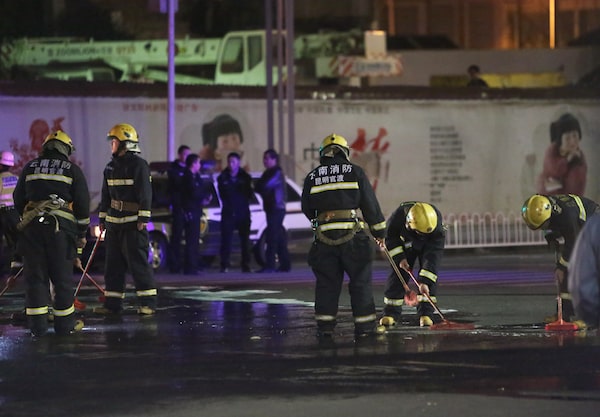
Firefighters clean the streets outside the Kunming railway station following a mass stabbing on March 1, 2014. By the time the attack ended, 31 people had been killed and another 143 wounded.STR/AFP/Getty Images
Kunming was the first inkling many in China and beyond had of the growing unrest and violence in Xinjiang.
A Uyghur-majority region with a history of independence from Chinese rule, Xinjiang had long been distinct from the rest of the People’s Republic, avoiding some of the worst excesses of the Mao Zedong era.
This changed however as the Chinese economy grew and Beijing looked westward. Even before Mr. Xi unveiled his signature Belt and Road Initiative, a globe-spanning trade and infrastructure project, Xinjiang was identified as a key exit point for Chinese goods headed to markets in Central Asia and Europe.
Han Chinese immigrants began pouring into Xinjiang, and government policies that promoted Uyghur language and culture gave way to a more assimilationist approach. Beijing began to warn of the threat of violent separatists, later recast as Muslim extremists following the U.S. launch of its global “war on terror” in 2001.
In the wake of deadly inter-ethnic violence in the capital Urumqi in 2009, Xinjiang was cut off from the internet for almost a year, and new restrictions introduced on religion. Fasting for Ramadan was discouraged, and women were banned from wearing the veil and men from growing long beards.
Many Uyghur activists and intellectuals were detained, while Uyghurs studying and working in the Chinese interior faced new suspicion and hostility. An exodus began, those with passports flying to North America, Europe and Turkey, which has a large Uyghur diaspora, while others took advantage of human trafficking routes into Southeast Asia.
Throughout 2013, news of growing clashes between Uyghurs and the Chinese authorities began to filter out of Xinjiang. State media described these incidents as terror attacks and blamed them on overseas Islamist groups, though the actual facts were often hard to confirm.
In October of that year, a group of Uyghurs drove a car packed with cans of gasoline into Tiananmen Square in Beijing. Three passengers and two tourists died in the incident, which the authorities said was a “carefully planned, organized and premeditated” terrorist attack.
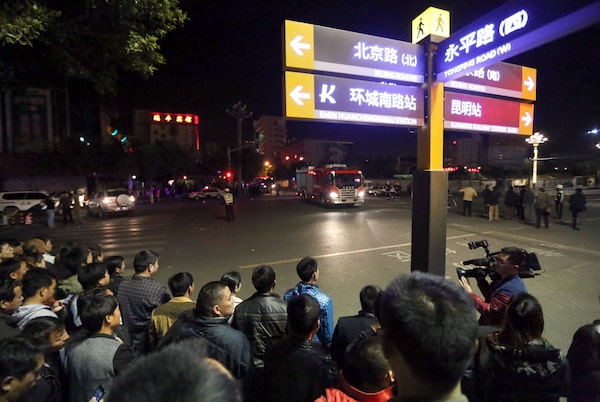
Police investigators, top right, inspecting the scene outside the Kunming railway station after the attack.STR/AFP/Getty Images
Adrian Zenz, a leading researcher on Chinese policies in Xinjiang, said attacks outside of the Uyghur region “forced the government in Beijing to become more proactive or face the wrath of Chinese citizenry.”
“The Han Chinese population would not have accepted any further attacks in mainland China,” he said. “It put significant pressure on the government.”
The attacks in Beijing and Kunming accelerated the adoption of policies that were already being experimented with by 2012, Dr. Zenz said, and would set the groundwork for the crackdown that followed.
In April, 2014, weeks after the Kunming attack, Mr. Xi visited Xinjiang, where he gave a series of secret speeches to top officials – the text of which has since been leaked – calling for an all-out “struggle against terrorism, infiltration and separatism” using the “organs of dictatorship,” and showing “absolutely no mercy.”
Mr. Xi was “approving and confirming an existing process,” Dr. Zenz said. “By that time, a lot of the decisions were made, a lot of the language and direction had been set in terms of the general policy approach.”
Abduweli Ayup was in prison at the time of the Kunming attack, jailed for “illegal fundraising” to set up Uyghur language schools. He said the crackdown had already begun by early 2014, and only escalated following Mr. Xi’s visit to Xinjiang.
“At one point, they had to transfer me to a new detention centre because the original one was full of Uyghurs,” he said. “When I got out, people didn’t know anything. My cousins and relatives accused me of exaggerating.”
He began seeing features he associated with prison – such as surveillance cameras and police checkpoints – popping up all over Xinjiang. Uyghurs had to show ID cards to enter certain neighbourhoods, and the police began showing up at large family gatherings, asking why so many people were meeting.
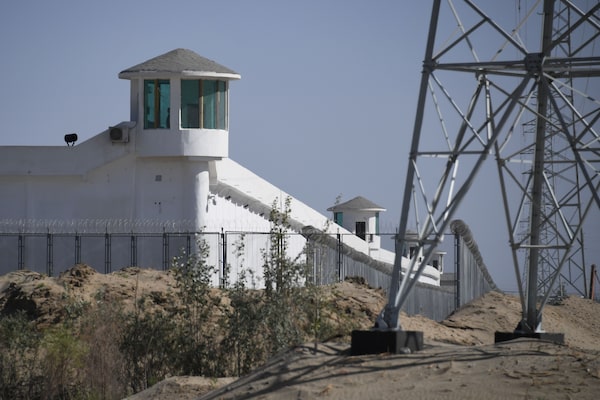
Watchtowers stand near a high-security facility at what is believed to be a re-education camp where mostly Muslim ethnic minorities are detained, on the outskirts of Hotan, in China's northwestern Xinjiang region on May 31, 2019.GREG BAKER/AFP/Getty Images
Dr. Zenz said it was around this time the Chinese government “selected centralized mass re-education as the policy to go for.” Within years, hundreds of thousands of Uyghurs would be detained, for purported offences such as going to mosque too often, violating family-planning policies, or communicating with relatives overseas.
China did not officially admit what was going on until late 2018, following numerous reports in the international media and by human-rights groups. In October of that year, the Xinjiang government introduced a new law calling for “vocational skill education training centres” to “carry out anti-extremist ideological education.” A propaganda blitz was launched to justify the crackdown as vital for fighting terror – with Kunming as a frequently cited example.
“This narrative was always being used; the Chinese government wanted to whitewash their policies,” Mr. Ayup said. “I don’t think Uyghurs as an ethnic group are all good guys or that there are no terrorists. People who attack civilians in a train station, they are terrorists, no question. But you can’t accuse 12 million people of terrorism because of what eight people did.”
In 2022, the United Nations said China had committed “serious human-rights violations” in Xinjiang that might amount to crimes against humanity. By this point, detentions had peaked, and the government said most Uyghurs had “graduated” from the camps, though tens of thousands are believed to have been transferred to the regular prison system.
Assessing the current situation can be difficult. Independent trips by journalists to Xinjiang are rare, owing to intense surveillance and restrictions on movement, as well as the potential risk to interviewees. Foreign observers and members of the Uyghur diaspora say repression is continuing, and many in Xinjiang still live in fear of being detained should they step out of line.
“People have already learned what is dangerous,” Mr. Ayup told The Globe and Mail from Norway, where he runs Uyghur Hjelp, a platform documenting detentions in Xinjiang. “They self-censor.”
Dr. Zenz, who has spent years studying Chinese government documents and leaked directives, said this was always the plan.
“In June, 2018, Chen Quanguo says the police state will be backgrounded without diminishing its abilities or power,” he said, referring to the former Xinjiang party chief. “It was replaced with a focus on development, but development with a coercive edge.”
Pointing to reports of large-scale forced labour in Xinjiang, Dr. Zenz said, “These are coercive measures but they’re not camps, they’re not an open police state.”
In January, the UN Human Rights Council cited “interlocking patterns of severe and undue restrictions on a wide range of human rights” in Xinjiang and called on China to “undertake a full review of the legal framework governing national security, counterterrorism and minority rights.” But Beijing has largely weathered the years of intense international criticism, denouncing allegations of genocide and forced labour as Western lies and maintaining close ties with much of the Muslim world.
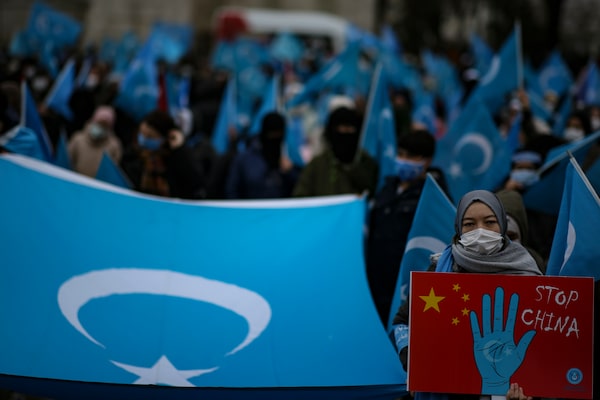
A protester from the Uyghur community living in Turkey, holds a sign during a protest in Istanbul, on March 25, 2022.Emrah Gurel/The Associated Press
Henryk Szadziewski, U.S.-based director of research at the Uyghur Human Rights Project, said that today “what I get a sense of is China’s ‘mission accomplished’ moment.”
“First they denied this was happening, then they pivoted to the vocational training centre narrative, saying look, the West bombs Muslims but we give them education,” he said. “And now it has mushroomed into this idea that China can be some sort of role model for the world, that through this terrible set of policies, they know how to quell ‘extremism,’ and that’s what we’re seeing with this latest ‘beautiful Xinjiang’ propaganda push.”
Since China lifted COVID restrictions, the government has been arranging tours to Xinjiang for carefully selected foreign journalists and dignitaries, who can be relied upon to give a positive report. It has also been encouraging Chinese influencers to visit the region, which is being promoted as a domestic tourism destination.
And while the terrorism narrative has taken a back seat to promoting “beautiful Xinjiang,” it has not been completely forgotten. A university in Guangdong recently published a collection of oral histories from victims of terror attacks in Xinjiang, which project organizer Zhang Liang told state media was designed to counter claims by “some overseas organizations” that terrorism “does not exist in China” or “that terror attacks are the result of oppression against ethnic minorities.”
“The project is to support China’s counterterrorism and de-radicalization efforts, making the international community aware that China, like other countries, has suffered from terrorism, and China’s counterterrorism efforts are justified and legitimate,” said Mr. Zhang.
 James Griffiths
James Griffiths